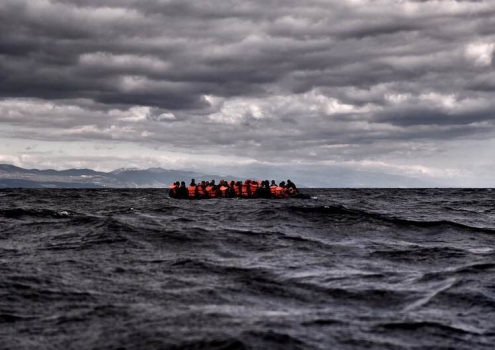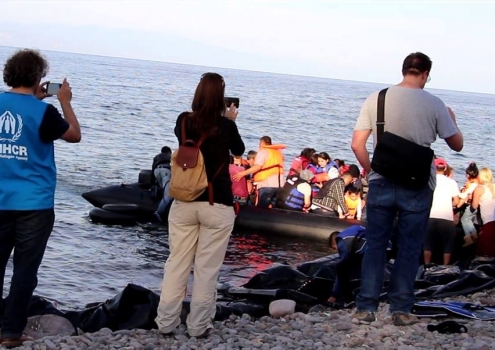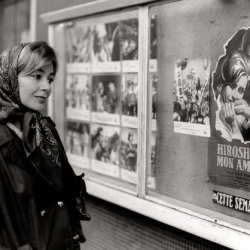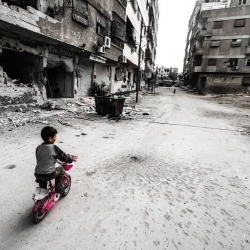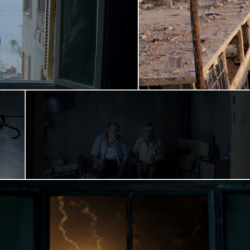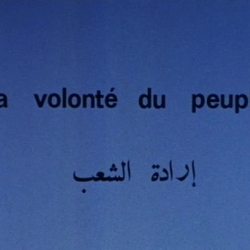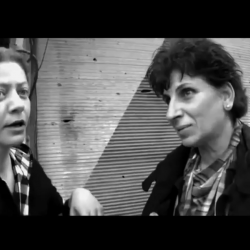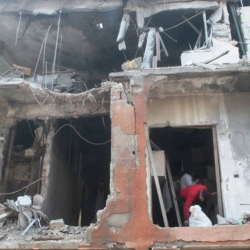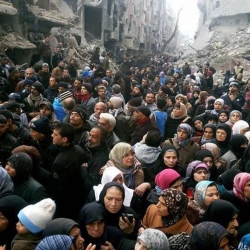Representing Refugees 2: A Blueprint for Navigating the Exterior
10/08/2016
Author: Roger Outa
On their rafts plowing waters and waves, the escapees embark. Throughout their sea adventure, they forge their exterior. The deeper they penetrate it, the more it widens; the more they traverse it, the more it unfolds. At sea, they withdraw to themselves, beginning their lives on sweeping flowing land on which they live their seclusion. The sea grants them seclusion that allows them to navigate and conquer it by moving steadily on its surface. They cannot forego seclusion, for such act would lead them to the abyss; neither can they remain within it, because seclusion intensifies as the sea widens. From within seclusion, they carry their cameras and film their journey through the exterior as they attempt to maneuver it. If to the exterior they withdraw, from it they emerge. In so doing, they defeat death and the Immortal, obliquely, freely, and repeatedly. As they brush aside nihilist representations of their flight, they make a life for themselves.
Excavations from the Abyss
At sea, escapees exist in isolation, one that turns the sea into a vast space that the eye cannot bear, particularly when the beholder constantly faces imminent drowning. Here, the sea becomes a landscape locked up in its Immortality, one that foresees death looming from its cavity—death by devouring. But the moment escapees film the sea, they turn it from a closed totality into an accessible one. They wish to safeguard their exterior from its Immortalizing power that could throw them back to the regime they fled, one in whose shade they did not exist, both before and after their eradication. Now that they exist, they are resilient. And so, they forge a relationship with the sea by means of the camera, set to delineate the sea’s features, turning it into to a containable space. As such, the sea is freed from its vast depths and opens up to its wide surroundings as the lens contours it. Rather than eliminating its width, the camera delineates it for the escapees, making their existence possible and ushering them into their life.
In this video, the words of the travellers are indecipherable, except for this realization: “Here, one feels disoriented”. Indeed, the filmed landscape is rippled due to the stormy sea. But this does not affect the stability of the lens that rises and falls as the raft tilts. It settles on the raft, as though appropriating it, becoming, in turn, its raft and that of the escapees. Only the lens is stable in the flow of waves. With each outburst of the sea, the lens moves its image from an anchored raft to a moving one. In so doing, it approaches the sea, captures it thoroughly, as though it wishes to conquer it, and then turns to the escapees lying on the raft. Later, the lens moves from one sea to another, glimpsing at the escapees that navigate them. The two seas are however different: the lens reveals the first in a state of turbulence, signaling imminent drowning, so it approaches it in order to extract the second, which it reveals peaceful and undisturbed. The lens clings to the sea, and, as it captures the escapees, it reassures them that the sea is still their horizon. The lens extracts one sea from another. It unleashes the sea’s width from the highs and lows of its waves, creating horizon from its staggering abyss, ultimately reinstating its mobility.
The lens responds to the statement “Here, one feels disoriented”. It reiterates that, as it captures the sea, it directs it to its width, to the exterior of its abyss, while attempting to pull it out and rearrange it, so that it remains a horizon for escape. The lens’s depiction of the sea in these terms is more discernible in another video in which the camera reveals the escapees lining the two sides of the raft. In the space that separates them, the sea unveils. The lens does not encircle the sea, but rather opens it up by cutting through it and traversing it, splitting it in two: the first sea faces the lens, emerges in between the bodies of escapees in their life vests, while the second hides behind it, incognito. As the sea expands, it ceases to be the land of the Immortal, in which it is confined. Rather, it becomes, as the camera reveals, two connected seas facing each other. In the foreground, there is a visible sea, vanishing as soon as it is traversed; in the background, there is an invisible sea, soon to be traversed, a sea that remains infinite. As escapees navigate one sea to another, they move from the finite to the infinite; from the evident to the concealed; from what appears in the picture to what lies outside it. The camera is thus the path for traversing, not from outside its field of view to its inside, but rather from inside its field of view to its outside, a path that makes traversing possible.
The Shore of Environs
Not only does the camera portray the sea as Immortal land, but also it splits it in two: the first expires when it appears facing the camera, or behind the escapees, while the second lingers, because it is behind the camera, facing the escapees. It is clear from their movement that escapees move only from the visible sea to the invisible one. It is as though drowning, which stands behind them and does not face them, constantly looming over them, is not the anticipated unknown and infinite, but, rather, the anticipated known and finite. Drowning looms from the sea already traversed and not from that which has yet to be traversed. In other words, there are two types of deaths: the first is death by drowning, hindering mobility, attacking rafts, and threatening to capsize them before the camera ultimately thwarts it and keeps it behind the escapees/before its lens. The second type of death is that which the camera keeps away from its lens, invisible, behind it/facing the escapees, who, as soon as they advance towards death, they conquer it; the closer to it they get, the faster it escapes them. This is how escapees make a life for themselves.
As it obstructs mobility and drowns escapees, death approaches from the finite and visible sea, from within the picture. It strikes the boundaries of the infinite and invisible sea that lies outside the picture. Here, death channels the state of death, ISIS, which only acknowledges the escapees’ existence the moment it eliminates them. As they take the sea, and by means of the camera, those escapees wrestle with death when their lens places the sea in the realm of the traversed and prevents it from crawling to its back. As such, death stays behind them and does not face them.
In many instances, however, death strikes in between the two seas. In this video, the escapees reveal that the German coastguard obstructed their raft and kept them still at large. Here, the camera is not interested in splitting the sea in two—finite and infinite—but rather, it captures it panoramically (“look at the sea, look!”). In so doing, it blurs the boundaries separating the two seas, misleading death, and becoming, in turn, the surrounding sea that it captures. As death strikes, the camera does not extract one sea from another. Instead, it transforms the sea from exterior to environ, a world for escapees. Escapees do not cling to a sinking raft, because the moment death strikes it, they dive into the sea, to their environ, as if it were their shore. Once they touch the sea, they swim in it. The opposite of swimming is not touching the shore, but rather drowning.
Death may strike escapees without hitting the raft, but merely by intercepting it. As such, the camera turns the raft into environ, a world for escapees. But at this very moment, the photographer may reveal his face as this video shows. Few are the scenes in which the escapee-photographer reveals himself, for he usually remains concealed. But when disaster strikes, he may move his lens from the sea to his face and back. As the holder of the camera, he is revealed in death-free videos at the borders between the finite sea and its infinite counterpart, at the range of death that usually hits there. When he films the sea and turns the camera to his face with the first signs of death, it seems as though he provides escapees with environ, a world, in the same way he provides himself with environ and world. The face in this context is both the sea of the escapee-photographer and his environ: in it, he dives as though it is shore and in it, he may swim.
From Presence to Another
How, then, do escapees negotiate their relationship with the sea by means of the camera? How do they safeguard it as their exterior, as the horizon of their mobility? As it has been noted, escapees move from one state to another. At first, they extract the sea from its depth and then split it in two: The first, finite, lies behind them; while the other, infinite, lies before them and to it they proceed. When death strikes in between the two (in)finite and (in)visible seas, escapees transcend the binary they created, making the sea their environ and their world, in which they dive and swim. But what do they do next?
This video has the answer. The camera captures the sea that faces the escapees and simultaneously places it behind them (“Here, you are disoriented”). It makes absent the sea present behind them, even when the lens captures it. We hear the photographer saying: “On this side, there’s nothing”. One could say that the scene points to the escapees’ new position: facing them is an infinite sea as traversing it is still imminent; behind them there is no finite sea, but rather something else, their seclusion that has replaced the finite sea and expired. From seclusion, they moved to presence and became present.
It is important to narrate the escapees’ story once more. Insofar as it is a vast space, the sea granted escapees seclusion, on which their existence is predicated. From then on, they proceeded in their adventure in which, they forged a relationship with the sea by means of the camera, by attempting to excavate it from the depth of its Immortality and splitting it in two. When death strikes between the two poles of the binary, as it always does, they transform it into their environ and world. If, however, death does not strike, they transcend this binary by traversing the sea and not by diving into it. As such, the sea faces them. Behind them, nothing but seclusion exists and because they no longer inhabit it, the sea seems finite.
When they become present, as the aforementioned video shows, an escapee asks the photographer whether he is recording or taking pictures, to which he replies: “Video. For us to watch.” This makes them both photographers and viewers taking pictures now so they can watch themselves later, as though their selves do not belong to them, as though by watching they will know that they have parted with them. They have made an image of themselves that they did not attempt to perform. Inasmuch as it is produced by the camera, the image represents them indeed, and they, too, represent it until it is exhausted and forgotten. Pictures are made to be forgotten; they are not there to self-perpetuate, but rather to be transcended. Lenses grant escapees a living and tangible representation of themselves, one that does not interrupt their mobility or terminate it. Rather, it safeguards it by allowing them to reach out to their fluid exterior and traverse it as they transcend their seclusion in it. Similarly, such representation allows them to maintain their steady progress toward the indefinite, transporting them from seclusion to presence. And so, having existed in seclusion, they are now present by its means. As seclusion subsides, they became other. The “us” that the escapee uttered before his companions (“for us to watch”) is one that is forthcoming; it is the “us” of others, which can only be erected on presence.
A flowing “selfie ”
Syrians are now present and do not cease to validate their presence. Meanwhile, they part with the sea and approach the mainland. Validating presence is certainly not equivalent to ending it inasmuch as parting with the sea is not equivalent to eliminating the width that constitutes it. Refugees move from the traversed to the non-traversed, from the finite to the infinite. This is clear in the footage of their approach to the shore, where the photographer, as this video reveals, turns his lens to the traversed sea then back to the mainland, placing it before the finite. In this sense, mainland replaces the infinite, for it constitutes now its space. Mainland is not the end of the infinite, a point of arrival to its end. Rather, it is one of its many possibilities, as mobility does not end there, but rather, it is sustained by escapees. Here, mainland is not the opposite of the sea, but rather the horizon of its infinity that the escapees have attained. In other words, it is their other sea.
In this video, the photographer announces that he and his companions have reached Greece. But, instead of filming the mainland that they have just reached, he films the sea. Thus, the sea replaces the mainland, as if their journey has led them to it. In other words, they navigated the mainland and touched the sea. The lens entirely transforms mainland into sea and sea into mainland. And so, the lens unites sea and mainland based on the fluid land they have in common and on the condition that they shall be traversed, a move that begins at arrival.
The camera affirms that the geography of the escapees is fluid, flowing. When escapees fall into it, they emerge in its mirror. By means of the camera, they exercise their presence and validate it, so they can transcend it. As they approach the shore and before touching it, escapees sometimes film their faces, as the escapee-photographer does upon announcing arrival. Similarly, after reaching the shore, he may do it again saying: “And there’s the sea”. It is common for escapees to capture their faces on the shore, producing “selfies” depicting the sea in the background: “Sealfie!”
It is important to make sense of such “sealfies” that not only reveal one’s face, but also the sea. By means of this pose, the escapees validate their presence through their faces suspended on the flowing space that seems to constitute it. In other words, the escapees film their faces as a sign of their presence, by suspending them on the sea. In so doing, they insist on their presence as they traverse, as though they are saying: “Here we are, our face is the remainder of the sea we traversed and that is now behind us”. However, since the mainland is another sea, escapees will not remain in their faces, but will transcend them. They are not confined to their presence, but rather, they transcend it by filming their faces. As such, one could say that one’s face is the shore between two seas, between that which has been traversed and the other, which has not; between the finite and the infinite. A new way of reading the pose: “Facing me is my traversed face; facing me are my shore and sea”.
Initiations
Appearing by means of the face is a way of validating presence, a way of navigating. It is also a moment of proceeding toward the infinite. On the beach where refugee cameras gather to take se(a)lfies, media cameras assemble, rush toward the escapees, as a means to capture them in images predicated on adverse representations of their presence. What do media cameras do?
Cameras capture refugees at sea, as though they are helpless, by filming their raft against a wide fluid landscape. In some reports, cameras capture them from a bird’s eye view, as though they are under surveillance. The point of the refugees’ trip, their only goal in life, is to disembark. And once they do, the media proceeds to interrogate them with inadequate questions such as “How was your trip?”, reducing thereby their perilous journey to the probability of drowning, survival, and suffering. It places them on its map by belittling them: “Do you know where you are?”. The camera zooms on their faces as though it encapsulates them all in one face, a face of sadness and fear. The media camera substitutes their exterior with its world; by replacing its milieu, in which they fall and move, with a number of conditions that scar them individually, similar to when they began their journey to eliminate the infinite to which they strive. However, although the media rushes to the refugees, it remains slow; It stands still, attempting to internalize them in the image it made of them, one that is merely an image through which it thinks refugees exist, through their performance of it.
When the world order captures refugees, it reveals its essence; in its image, it confines refugees. When it reveals them weak, sad, and helpless, it describes itself. And when it announces that they are without exterior, that their only world is its own interior, it speaks of itself. The world wants them in its image, so that it can manage them; it wants them in its image, for this is the most it can do. The world order fantasizes about a relationship with itself through them. As it realizes that this relationship is already annihilated, the world annihilates them. As for the refugees, they capture themselves to safeguard their mobility and make their world, so they can traverse seclusion to presence, and make selves that represent them and not representations that feign selves. But what matters the most is that they do not produce images in order to remain within them, for images are always set to arrange their path to the exterior making it the milieu that they overcome with the approach of death. This is how they make their future lives.
Refugees cannot be represented outside their own images. Such act prevents them from moving from within the image to its exterior and confines them within it, eliminating its exterior. Their representation must participate in producing and coordinating their movement, allowing them to resist their confinement and depiction that are similar to its own Immortal and lethal essence, one that parodies life so that it can annihilate it.
Syrians do not need images concerned with “reflecting their trials”, ultimately confining them in their misery, turning them into subjects of power and objects of pity. Similarly, Syrians do not need images that violate and eliminate their existence and presence. The images they need should pave the way for their existence and presence until images are exhausted, until Syrians no longer capture or represent.
This piece was translated from Arabic, click here for the Arabic text.



